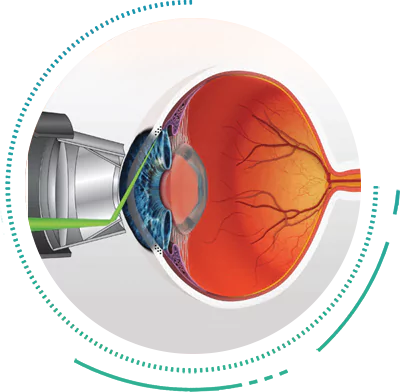Cutting-edge Refractive Surgeries in AL: Change Your Vision Today
Cutting-edge Refractive Surgeries in AL: Change Your Vision Today
Blog Article
Comprehending the Different Vision Adjustment Procedures Available for Clearer View
In the world of vision correction treatments, a plethora of alternatives exist to deal with refractive mistakes and give individuals with clearer view. From the widely acknowledged LASIK surgical treatment to much less invasive treatments like PRK and implantable lenses, the field of ophthalmology supplies a variety of strategies tailored to fit various demands and choices. Each procedure includes its very own collection of factors to consider, advantages, and prospective dangers. Comprehending the nuances of these vision adjustment techniques is vital for making educated choices regarding one's aesthetic health and wellness. Let's explore the complexities of these procedures and clarified the path to attaining boosted vision quality.
LASIK Surgical Treatment
LASIK surgical procedure is a typical refractive procedure used to deal with vision issues such as farsightedness, nearsightedness, and astigmatism - eyecare near me. This surgical method, which represents Laser-Assisted in Situ Keratomileusis, aims to reshape the cornea to boost how light is focused on the retina, eventually enhancing vision quality. Throughout the procedure, a slim flap is produced on the cornea, and a laser is used to get rid of exact amounts of tissue to improve it appropriately. This improving enables light to be accurately concentrated onto the retina, dealing with refractive errors.
One of the main advantages of LASIK surgical treatment is the quick renovation in vision experienced by patients. Overall, LASIK surgical procedure is a preferred selection for people looking for a lasting solution for their vision problems.
PRK Treatment
While also an usual refractive procedure, the PRK (Photorefractive Keratectomy) strategy differs from LASIK surgical procedure in its method to correcting vision issues. In PRK, as opposed to creating a flap on the cornea, the external layer of the cornea, called the epithelium, is completely eliminated. This allows the laser to reshape the cornea to deal with refractive errors such as astigmatism, nearsightedness, and farsightedness straight on the surface.

Regardless of the longer healing time, PRK can generate exceptional lead to vision enhancement, making it an important option for those who might not be suitable candidates for LASIK surgical procedure.
Implantable Lenses
In comparison to PRK where the cornea is reshaped directly, implantable lenses offer an additional method for remedying vision by placing fabricated lenses inside the eye. This treatment is specifically beneficial for individuals with high degrees of nearsightedness, astigmatism, or farsightedness that may not be suitable candidates for laser surgeries like LASIK or PRK.
Implantable lenses, additionally referred to as phakic intraocular lenses, job by supplementing the eye's natural lens with a man-made one. refractive surgeries in al. These lenses can be positioned before the all-natural lens (former chamber) or behind the iris and before the natural lens (posterior chamber) By changing the power and positioning of these lenses, ophthalmologists can efficiently fix refractive mistakes and improve aesthetic acuity
One advantage of implantable lenses is that they are exchangeable and detachable, offering flexibility for future changes. Nevertheless, similar to any type of surgery, there are risks involved, such as infection or cataract formation. Individuals thinking about implantable lenses should seek advice from with an eye care specialist to establish the most suitable choice based upon their private needs and eye wellness.
Corneal Rings
Corneal rings, also referred to as intracorneal ring sections, are tiny, clear gadgets inserted right into the cornea to correct vision distortions such as keratoconus. Keratoconus is a problem where the cornea thins and bulges external, causing vision to come to be distorted. The insertion of corneal rings helps to squash the cornea, enhancing aesthetic acuity and lowering the irregular astigmatism created by keratoconus.
The procedure for putting corneal rings is minimally intrusive and relatively quick, usually carried out as an outpatient treatment. During the surgical treatment, the eye doctor makes a little incision in the cornea and inserts the rings at a particular deepness. Once in location, the rings aid to improve the cornea, offering a smoother surface area for light to get in the eye, which can lead to more clear vision.
Corneal rings are considered a reversible treatment, as they can be eliminated or changed if necessary. refractive surgeries in al. While they may not totally get rid of the demand for glasses or call lenses, corneal rings can considerably enhance vision quality and general aesthetic comfort for individuals with keratoconus or other corneal abnormalities
Refractive Lens Exchange
Complying with the adjustment of corneal irregularities with procedures like corneal rings, another vision adjustment technique that can deal with refractive mistakes is Refractive Lens Exchange (RLE) RLE is a surgical procedure that involves replacing the eye's all-natural lens with a fabricated intraocular lens (IOL) to deal with refractive mistakes such as my explanation nearsightedness, farsightedness, and presbyopia. This procedure is specifically beneficial for individuals that might not appropriate prospects for procedures like LASIK or PRK due to elements such as thin corneas or high refractive errors.

Verdict
In verdict, there are numerous vision correction treatments readily available to aid people achieve clearer view. LASIK surgery, PRK treatment, implantable lenses, corneal rings, and refractive lens exchange are all alternatives that can attend to various vision problems.
In the world of vision modification treatments, a multitude of choices exist to deal with refractive mistakes and give people with clearer sight.LASIK surgery is a common refractive treatment made use of to fix vision issues such as astigmatism, this post farsightedness, and nearsightedness.While also an usual refractive treatment, the PRK (Photorefractive Keratectomy) method differs from LASIK surgical procedure in its strategy to remedying vision problems.Complying with the adjustment of corneal abnormalities with treatments like corneal rings, another vision improvement technique that can resolve refractive mistakes is Refractive Lens Exchange (RLE) LASIK surgical treatment, PRK procedure, implantable lenses, corneal rings, and refractive lens exchange are all alternatives that can address various vision problems.
Report this page